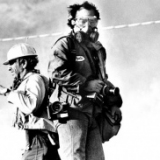- Forum
- General Discussion | Introductions | Off Topic Forum
- Photography General Discussion
- What was highest ISO in film photography during 1950's?
What was highest ISO in film photography during 1950's?
-
 Topic Author
Topic Author
- Paul Velasco
- Lone Wolf
-
- Canon EOS R and Canon 5D Mark IV
- Followers: 65
- Posts: 113
-
Points:
2292
Post #645566
Would you happen to know the answer?
Post #645579
Paul Velasco wrote: A friend and I have a little gentle mans bet going on with this question.
Would you happen to know the answer?
Is this a serious question? ISO is digital. There was no ISO in photography before digital cameras
-

- Nikon Shooter
- Oh Wise One
-
- 3S 3X 810 850
- Followers: 197
- Posts: 13795
-
Points:
88932
Post #645583
but that was a special technical solution that was not in the mass.
Usual commercial films — say ISO 400 — were often "boosted" up to
1 600 and developed consequently, stop and fix remained the same.
ISO has nothing to do with digital, I mean was not created by or for
digital photography. It was in 1987 — before digital — that ISO was
set to replace ASA & DIN that were the 2 world industry standards.
Light is free… capturing it is not!
-

- Shadowfixer1
- Photo Elder
-
- Olympus OMD E-M1 MKII
- Followers: 1350
- Posts: 5554
-
Points:
73334
Post #645585
You might want to rethink that thought.Troponin wrote:
Paul Velasco wrote: A friend and I have a little gentle mans bet going on with this question.
Would you happen to know the answer?
Is this a serious question? ISO is digital. There was no ISO in photography before digital cameras
The ASA and DIN film speed standards have been combined into the ISO standards since 1974.The current International Standard for measuring the speed of color negative film is ISO 5800:2001 [17] (first published in 1979, revised in November 1987) from the International Organization for Standardization (ISO). Related standards ISO 6:1993 [15] (first published in 1974) and ISO 2240:2003 [16] (first published in July 1982, revised in September 1994, and corrected in October 2003) define scales for speeds of black-and-white negative film and color reversal film, respectively.
-

- Shadowfixer1
- Photo Elder
-
- Olympus OMD E-M1 MKII
- Followers: 1350
- Posts: 5554
-
Points:
73334
Post #645590
In 1961 Kodak released Kodachrome II with sharper images and faster ASA speeds at 25 ASA. In 1962, Kodachrome-X at ASA 64 was introduced. In 1974, with the transition to the K-14 process, Kodachrome II and Kodachrome-X were replaced by Kodachrome 25 and Kodachrome 64.
Post #645593
I remember 800 and 1000 speed films. I'd take a wild guess of the '60s maybe before there was 400 speed film. 100 or 125 ASA/DIN could have been the highest in the '50s (125 was a standard for a time). Or maybe it was sooner/later than I'm guessing!
Sharon
-

- Shadowfixer1
- Photo Elder
-
- Olympus OMD E-M1 MKII
- Followers: 1350
- Posts: 5554
-
Points:
73334
Post #645595
High Speed Ektachrome, announced in 1959 provided an ASA 160 color film, which was much faster than Kodachrome. In 1968, Kodak started offering push processing of this film, allowing it to be used at ASA 400
Post #645608
i was speaking literally, but y’all are speaking theoretical. It can’t be literal because it’s a digital unit of measurement
-

- Shadowfixer1
- Photo Elder
-
- Olympus OMD E-M1 MKII
- Followers: 1350
- Posts: 5554
-
Points:
73334
Post #645612
I must be in the twilight zone. If it wasn't called ISO after 1974 then what was it called? I am not trying to be difficult either but to say ISO is only a digital concept is absurd. Go look at a roll of film and tell me what it says before the 64 or 100 or whatever speed it is. I can assure you it was on the cannister way before digital was thought of. In fact, technically there isn't such a thing as ISO in digital. ISO in digital is actually a signal gain measurement that mimics ISO in film.Troponin wrote: I am aware there was a unit of measurement in film, but it was not called ISO. You’re talking about a relative concept.
i was speaking literally, but y’all are speaking theoretical. It can’t be literal because it’s a digital unit of measurement
-
 Topic Author
Topic Author
- Paul Velasco
- Lone Wolf
-
- Canon EOS R and Canon 5D Mark IV
- Followers: 65
- Posts: 113
-
Points:
2292
Post #645633
Post #645692
I threw away the boxes after I opened them so I'll have to go look in the fridge to see how boxes are marked...
The ISO means the measure of light sensitivity according to International Standards (which used to be ASA, American Standards and DIN, the German equivalent that stands for Deutsche standards - don't ask me to translate or spell it!). Like Randy said, been around long before digital photography existed.
Early in photography cameras weren't marked because I think one speed was all there was, I don't think they were making emulsions yet with more/larger silver grains to be more light sensitive. But when they did, eventually they were standardized.
Sharon
-

- Nikon Shooter
- Oh Wise One
-
- 3S 3X 810 850
- Followers: 197
- Posts: 13795
-
Points:
88932
Post #645694
Troponin wrote: it’s a digital unit of measurement
No, it is the only system used in DP but it was established well before.
Light is free… capturing it is not!
-

- GaryA
- The Lounger
-
- Fuji Stuff
- Followers: 132
- Posts: 1180
-
Points:
10945
Post #645714
Agfa released Isopan Record- ASA 1200 in the late 1950's (I believe).
Ilford released HP3- ASA 400 in 1941.
Illford released HPS- ASA 800 in 1954.
Shooting news (1970's-1980's), all I used, (and most everyone else who shot B&W for news), was Tri-X. For low light we'd push it up to ASA 1600 then overdevelop.
There are photographs everywhere. It is the call of photographers to see and capture those images.
www: garyayala.com
-

- Moe
- Apprentice
-
- Canon 5D Mark III
- Followers: 251
- Posts: 2144
-
Points:
11834
- Forum
- General Discussion | Introductions | Off Topic Forum
- Photography General Discussion
- What was highest ISO in film photography during 1950's?
Latest Reviews
The Canon EOS R100 is an entry-level mirrorless camera introduced in 2023. But just because it’s an entry-level camera doesn’t mean it’s a bare-bones camera. Find out why in this review!
Nikon’s retro-looking Nikon Zfc is anything but retro. Under its classic body is a host of features and amenities that make it a worthwhile compact mirrorless camera for 2024.
The Canon EOS R50 is one of the newest R-system cameras from Canon. Is it worth your money? Find out all the details you need to know in this comprehensive review.
The Sony FE 70-200mm f/2.8 GM OSS II is Sony’s flagship mirrorless zoom lens. As such, it’s loaded with features and has a top-shelf build quality that makes it a top pick!
Latest Articles
Creating impactful photos of landscapes depends on many factors, not the least of which is your talent behind the lens. This guide explores other elements required for the best product.
The Canon EOS R100 is an entry-level mirrorless camera introduced in 2023. But just because it’s an entry-level camera doesn’t mean it’s a bare-bones camera. Find out why in this review!
Are you ready to upgrade your camera? Before buying new, you might consider the value of purchasing used gear to save money.
The Olympus OM-D E-M10 Mark IV is a micro four thirds camera released in 2020. It’s an entry-level system along with the OM-D E-M5 Mark III. Use this guide to determine which one is best for you!
Blue hour photography might not be as well known as golden hour photography, but it is every bit as good a time to create epic images of landscapes. Learn how in this quick tutorial!
Nikon’s retro-looking Nikon Zfc is anything but retro. Under its classic body is a host of features and amenities that make it a worthwhile compact mirrorless camera for 2024.
Moving from taking snapshots of your dog to creating beautiful images doesn’t have to be that difficult! Use the tips outlined in this dog photography guide, and you’ll get better results in no time.
Acrylic print photos are a beautiful way to display your favorite images. But they don’t come without some questions. Get all the answers you need about this medium in this guide!
















